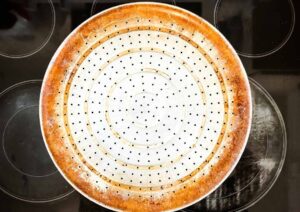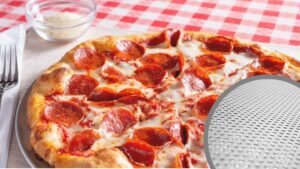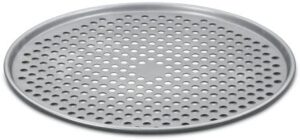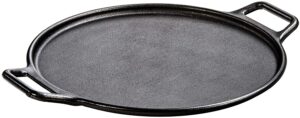Choosing between a pizza pan with holes and no holes can be the hardest task under task when you want to ensure a perfect crust under your toppings. There are different kinds of pans you can use for the pizza, and also, they come in different shapes to suit different pizza styles.
You can use deep-dish pizza pans, pizza screens, regular pizza pans, cast iron pizza pans, and wide-rim pizza pans. Now out of the pizza pans, you have the ones with holes and those without holes.
Each type has its merits and demerits, and before choosing one, you should first sort out the expectations you attach to a pizza pan. In this post, we’ll take a detailed look at pans with and without holes and how they influence the outcome of your pizza.
Key Difference between Pizza Pan with Hole and No Holes
A perforated pizza pan allows heat to circulate underneath the pizza crust and lets the buildup steam escape, creating an airy and crispy crust for thin-crust pizzas. On the other hand, a pizza pan without holes aims to create a soft pizza crust by retaining the moisture released by the pizza crust–it’s more suitable for thick-crust pizzas.
Differences Between Pizza Pans with Holes and No Holes Explained in Detail
Let’s begin with deciding between the right pizza pan here.
Pizza Pan with Holes

Perforated pizza pans, also referred to as pizza pans with holes, usually made of aluminum, are more suitable for thin-crust pizzas. Perforations in the pan helps in creating crispy curst in two ways:
- First, the perforations allow the heat to reach the pizza crust directly to cook it in no time.
- Second, the holes allow the steam to release underneath the pizza crust. Thus, your pizza attains a perfect crispy crust.
Furthermore, when using a perforated pizza pan, there’s nothing like burnt, undercooked, or half-baked pizzas. Similarly, the pizza toppings are fully and quickly cooked with a fair amount of direct heat.
However, remember that perforated pizza pans are not meant to be used on thick crust pizzas. On the contrary, these pans work excellently for thin-crust pizzas and make the pizza less chewy while retaining the original taste of the pizza.
Pros
- It allows steam esacpe to make pizza crispy, crusty, and less sweet.
- The holes allow more heat to flow through, making your pizza well-cooked.
- It takes much less time to cook a pizza base.
- The pan can easily reheat the leftovers or half-cooked parts using a perforated pan.
- It’s made of aluminum, meaning that it’s more durable and cost-effective than other options.
Cons
- Pizza pans with holes can cause pizza burn if cooking process is not monitored properly.
- You can’t use these pans for several other cooking purposes.
- Cleaning aluminum pans is quite an effort.
Pizza Pan with no Holes

Smooth pizza pans or pans with no holes are meant for thick-crust pizzas. These pans allow less heat to reach the crust and prevent moisture loss underneath the crust from a perforated surface. Therefore, the resulting pizzas are moist, softer and sweet. In addition, pans without holes don’t let the moisture escape and retain it. The outcome is a chewy, sugary, and less crispy pizza.
It’s worth noting that the pizza takes more baking time in a pan with no holes.
However, the biggest drawback of smooth pizza pans is the slow distribution of heat, which may also cause pizza toppings to cook slowly. And, if awaited longer, the pizza crust or cheese may burn.
The good news is that pizzas cooked in these pants have specific recipes that require you to partially cook toppings before adding them to the pizza.
One of the biggest benefits of perforated pizza pans is their versatility. You can use these pans for cooking several other recipes, including pies, cookies, and pasta.
Another advantage is that it’s easy to clean compared to a pizza pan with holes. Adding oil to these pans is a no-brainer. Although they’re not as lightweight as holed pans, they’re still easy to handle.
However, if you’re using a cast iron pizza pan, it may require maintenance.
Pros
- It offers more functionality, allowing you to bake pies, cakes, and multiple other options.
- Adding oil to a baking pan with no holes is easy.
- It’s easy to use, maintain, and clean.
Cons
- It takes more time to heat up.
- It weighs more than a holed pan.
- It cooks slowly. Hence your pizzas can take a lot of time besides coming with soggy centers.
- Chances of burns and leftovers are higher with a pizza base while using a pan with no holes.
Pizza Pans wih Hole vs. No Holes: Summarizing the Differences
| Feature | Pizza Pan with Holes | Pizza Pan without Holes |
| Ideal for Crust Type | Thin-crust | Thick-crust |
| Heat Distribution | High and direct | Lower and indirect |
| Steam Escape | Allows steam to escape, creating a crispy crust | Retains moisture, creating a chewier crust |
| Cooking Time | Faster | Slower |
| Crust Texture | Airy, crispy, less sweet | Moist, soft, sweet |
| Topping Cooking | Faster and more even | Slower, may need pre-cooking |
| Burning Risk | Higher, needs monitoring | Lower, but crust or cheese can burn |
| Versatility | Limited (mainly pizza) | High (pies, cakes, pasta) |
| Cleaning | More effort (holes) | Easier |
| Material | Usually aluminum | Various (aluminum, steel, cast iron) |
| Cost | More affordable | Varies, cast iron can be expensive |
Conclusion
Selecting the right pizza pan can significantly impact the outcome of your homemade pizzas. If you crave a crispy, well-cooked pizza with bubbling cheese and perfectly browned toppings, a perforated pizza pan is your go-to choice. These pans allow even heat distribution, ensuring your pizza is cooked to perfection in less time.
On the other hand, if you prefer a thicker, doughier crust or want to experiment with stuffed crust pizzas, a smooth pizza pan without holes is the way to go. These pans offer versatility, allowing you to use them for various baking needs beyond just pizza.
Remember, the best choice ultimately depends on your pizza preferences and cooking style.
FAQs
What are pizza screens?

Pizza screens are flat, with round disks of aluminum mesh. However, while round screens are the most common, they’re not always round. It’s not uncommon to find a rectangular pizza screen. As for the size, rectangular screens are more extensive than circular ones.
Most pizza screens are non-stick, durable, and dishwasher-safe. Pizza screens offer better heat distribution and air ventilation to the baking surface, so they’re suitable for cooking crusty pizzas in conveyor and convection ovens.
While you can use pizza screens in place of a pan, they’re generally best for achieving a crispier crust. If you want more from a perforated pan, they might be the best option for you. However, if you crave chewy, sweet pizzas, a pizza screen is just useless for you.
The screens are for those unsatisfied with the results of a traditional perforated pizza pan and want a more crispy, thin output.
How do you use a Pizza Crisper Pan?

A pizza pan with holes is sometimes also referred to as a pizza crisper pan. The reason behind the name is that the perforated pan makes the pizza more crispy and tasty.
Using a pizza crisper pan is easy. Follow these steps to make a super crispy pizza with the help of a pizza crisper pan:
Step#1 Spray the oil
First of all, you need to spray a good quality. Non-stick cooking spray on a perforated pizza pan. If you don’t have cooking spray available, you can simply rub the surface of the pan with olive or canola oil.
Step#2 Roll the dough out
Secondly, you must roll the whole wheat flour dough into a thin layer. While doing so, keep sprinkling the dough and rolling pin with the flour as it’ll prevent the dough from sticking to the pin.
Step#3 Lay the crust out
Gently place the rolled-out crust in the pan while ensuring that it doesn’t spread over the edges of the pan.
Step#4 Bake
Bake the pizza in the pan. While doing so, you can keep adding the desired toppings. Select the toppings that offer high nutritional value.
If you follow these steps correctly, you can remove your pizza using a pizza peel after it’s done.
What’s the Best Pizza Pan with Holes?

Cuisinart Chef’s Classic Nonstick Bakeware 14-inch is no doubt the best pizza pans with holes. It’s a top-selling pan on Amazon. The pan features many qualities like it is non-stick, which saves your pizza crust from breaking.
The aluminized steel construction ensures an even distribution of heat. Therefore, it’s also easy to clean.
How can we forget that it’s not expensive? Built to last over the years, it’s just a bang for a few bucks.
What’s the Best Pizza Pan without Holes?

The Lodge Cast Iron Pizza Pan, 14-inch, is one of the best pizza pans without holes. It has a rim and handles to prevent your pizza from sliding off as you remove it from the oven. This cast iron pan is pre-seasoned, so you won’t have to use oils to keep your pizza from sticking while cooking pizza.
Because of the black construction, you won’t have to deal with the staining that occurs with lighter-colored baking stones. Although this pizza “stone” costs more, its size and adaptability make it a great value. You can use it on the stove for dishes that don’t require a sauce and don’t create excessive liquid during the baking process.
What kind of pizza pans do restaurants use?
The restaurants mainly aim at producing doughy pizza out of a slow baking process instead of thin crust pizza. That’s why the coupe pizza pans with aluminum material are commonly found in restaurant kitchens as pizza equipment.
Which pizza pan should I use for a thin-crust pizza?
The perforated pan makes the best choice to achieve a thin and crispy crust under the delicious pizza toppings. However, if you love a pizza with a stuffed crust, go for a pizza pan without holes.
mama-cucina.com is a participant in the Amazon Associate program and will earn from qualifying purchases.
